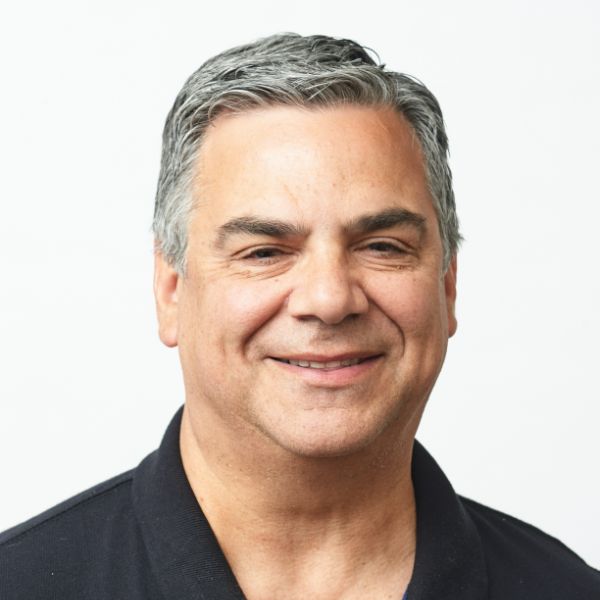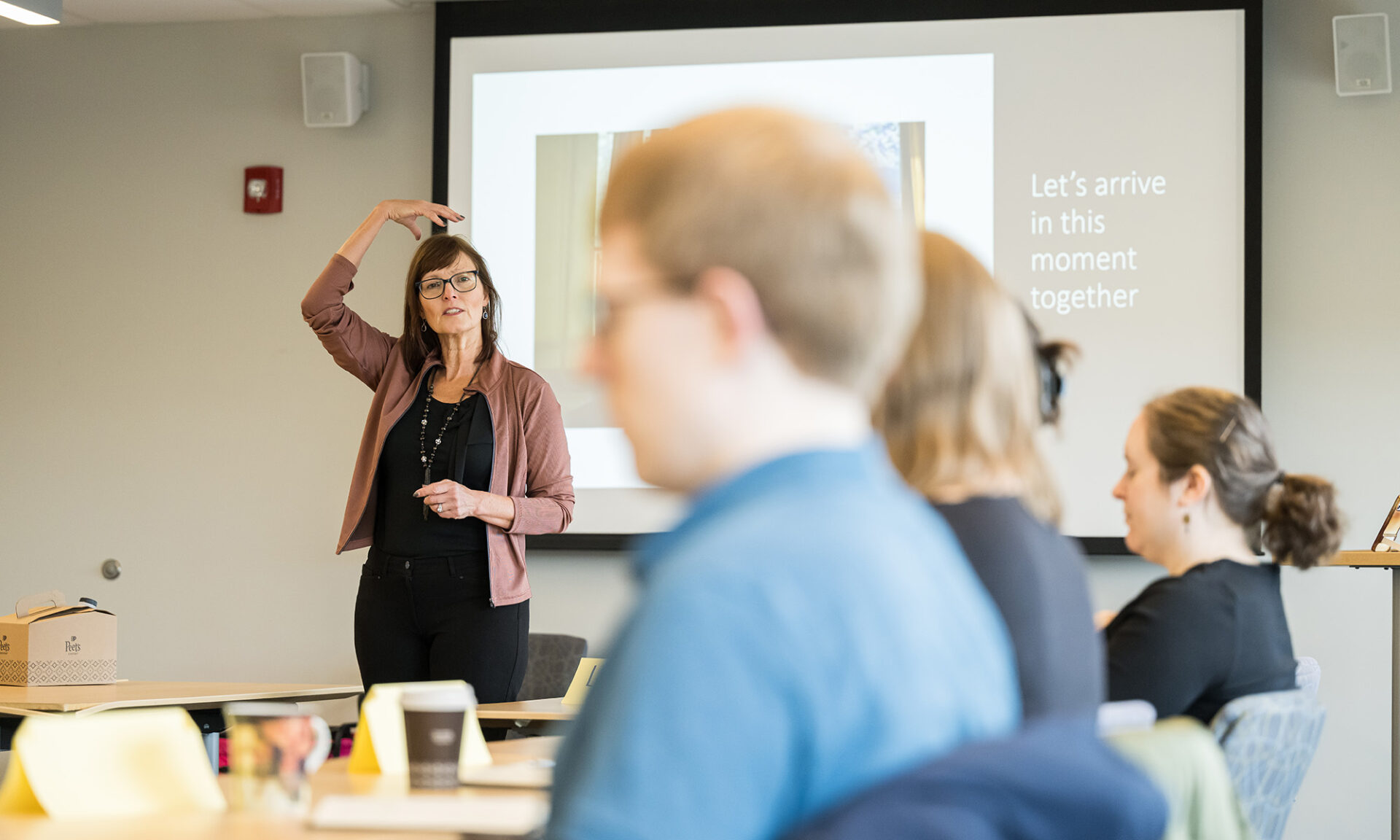A University program trains faculty to embrace mindfulness in the classroom, with instructors and students alike benefiting.
Kate Soules began teaching at the University of Rochester in the fall of 2020, at the height of the COVID-19 pandemic. What she observed in her classroom caused great concern.
“I saw students struggling to complete their work due to anxiety or other mental health issues,” she says. “Others showed an inability to focus, complete tasks, or participate in class. I had never experienced trying to teach students in such a state of distress. COVID caught everyone off guard.”
The University has long offered an array of mental health programs for students, such as its Health Promotion Office, University Counseling Center, and The CARE Network. And since 2018, the Mindful University Project, an initiative from the Health Promotion Office, has focused specifically on empowering the campus community to build a culture of mindful presence and compassion.
“The pandemic was a major catalyst for the rise of interest in mindfulness among the general public,” says Rebecca Block, director of the Mindful University Project. “People sought tools to manage uncertainty, anxiety and isolation.”
According to a Healthy Minds Network survey conducted in 2020, almost 80 percent of faculty reported having conversations with students regarding mental health and wellness, but only 51 percent said they knew how to recognize if a student was in emotional or mental distress.
“Substantial research has shown that mindfulness interventions for teachers can enhance their mental health and provide a more positive classroom environment,” Block says. “That’s the gap we wanted to fill.”
But there were no University of Rochester mindfulness leadership programs targeted at faculty—until 2023. That’s when the University’s Mindful Professor Training Program debuted, the first in the country aimed at mindfulness leadership practices for the faculty and instructors in higher education. Each semester, the program offers eight one-hour workshops aimed at teaching the teachers how to be calm and present in the classroom by using mindful leadership skills that support students’ well-being.

“Through my background in health promotion, education, yoga, and mindfulness, I’ve witnessed firsthand how much educator well-being can influence student learning, mental health, and a sense of belonging,” Block says. “Many faculty and instructors on campus shared my interest, which led to the creation of this program.”
Nearly 60 Rochester faculty members have taken part since its inception. All seven University academic schools—spanning the subjects of business, science, music, medicine, education, and the arts—have been represented.
Being calm, present, and grateful
Mindfulness means paying attention to the present moment—“with curiosity, openness, and without judgment,” Block says. It can many forms, from breath awareness and yoga, to Tai Chi and walking.
Soules, an instructor in the Writing, Speaking, and Argument program, heard praise about the mindfulness program for faculty from colleagues and decided to join the spring semester’s cohort in January.
“Those who have been through the program seemed more equipped going into stressful times and classroom situations,” she says. “In the writing program, we work so closely with students that it seemed like a no-brainer that the program could enhance the student experience and that the learning outcomes would be worthwhile.”
The group meets Monday mornings in Genesee Hall on the River Campus. During a spring session, the one-hour meet-up includes several exercises, some lasting minutes, one lasting seconds. The class begins with a meditation exercise run by lead consultant Lisa Critchley, whose doctorate is on the impact of mindfulness on leadership effectiveness and well-being. “Let’s arrive in the present together,” Critchley softly tells the group, whose eyes are closed. “Both feet on the ground, lift your rib cage, lengthen your neck. Now breathe.”
Critchley then asks the class to name something they’re grateful for, no matter how minor it may seem. One participant mentions a recent vacation with sisters. Another describes an easy return of yogurt at Trader Joe’s. Critchley recounts a birthday celebration with catered food from her favorite restaurant.
“No matter what’s happening, there’s plenty to be grateful for,” Critchley says. “We use this exercise to embed practicing gratitude daily.”

Block and Critchley’s ongoing research on the program’s effectiveness has determined that mindful educators promote higher levels of engagement with students. That builds trust with students and, ultimately, a calmer, more cohesive classroom.
“Together, we explored the impact of a mindful leadership training on educators, particularly those in higher education, and how that translates to their well-being, classroom environments, teaching efficacy, and student support—with the belief that the mood in the classroom starts at the top,” Block says.
Critchley says that professors set the tone as the classroom leader. “They need to take this calm mindset into class—and have the toolkit to do it,” she says. “By arriving in presence, the professor’s state is infectious through what’s referred to in psychology as the emotional contagion effect. In other words, the professor sets the emotional tone and creates the environment for students to come into a calm presence.”
The early results from post-training surveys are encouraging. Three months after taking the course, 100 percent of participants said they had incorporated mindfulness practices into their daily lives—and their classrooms. And 85 percent said they were either “extremely” or “moderately” confident in their ability to use mindfulness strategies to support student well-being.
Meanwhile, Block and Critchley’s examination into the positive impact of mindfulness programs for college faculty—and how it directly affects students’ mental health—has reached a scholarly audience with the publication of their research on the topic in the Journal of American College Health.
Bringing mindfulness into the classroom
Craig Sellers ’78N, ’88N (MS), ’09N (PhD), ’10 (PMC) a School of Nursing professor from 1997 until his recent retirement, was among the faculty participants in the the spring mindfulness workshops.
“Post pandemic, students had become distant—because we went to distance learning,” he says. “The mindfulness classes seemed like a cool way to learn some new ways of acting and interacting. Many of my students are future nurse practitioners. I thought they should learn how to take care of themselves so they can take care of patients.”
Sellers brought what he learned into the classroom before difficult medical exams. “The technique I used with students was a breathing exercise called ‘centering,’” he says. “It’s about focusing on the moment while letting go of what happened in the past or might happen in the future.”
The feedback was very positive. Sellers says that one student told him, “This is exactly what I needed. My mind was racing before the exam.”
Sellers now meditates daily. He can’t stress enough the importance of practicing mindfulness for nurse practitioner students. “We do a lot of stuff in healthcare that is very serious,” he says. “You need to be calm and present while engaging in those conversations.”
Block and Critchley hope to expand the program to reach more University faculty. This fall, they’re bringing the program to the Medical Center. In 2026, they’ll run a program at the Eastman School of Music. They also plan to develop a completely asynchronous version for individuals who wish to complete the program online.
“We’re still growing, but we’re encouraged by the early results,” Block says. “Participants report feeling more grounded, connected, and present. And most importantly, they’re better able to create inclusive, mindful learning environments. That’s a win for the instructors and the students.”
This story was initially published on May 5, 2025. It was updated on May 23 to reference research published in the Journal of American College Health.




